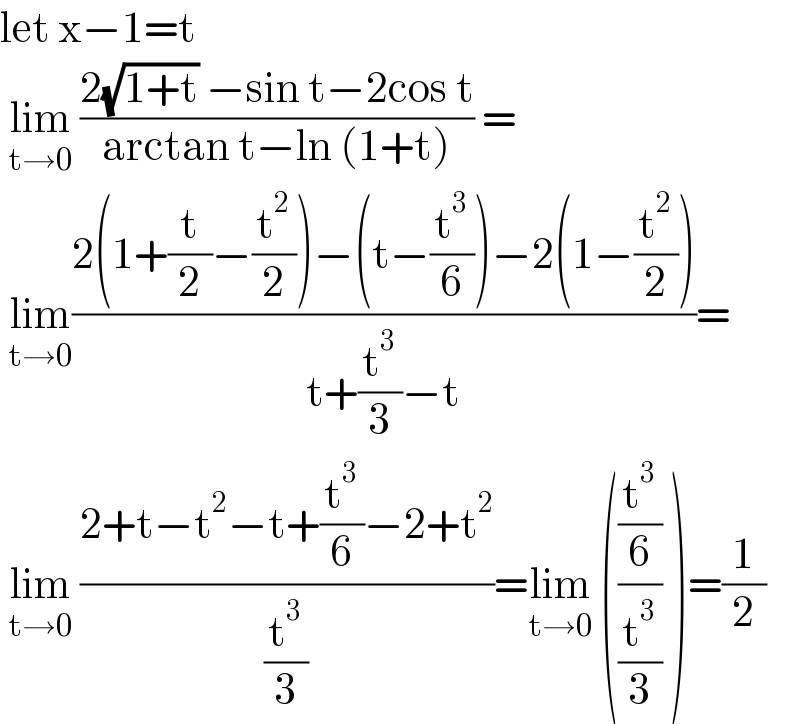Question Number 129098 by Adel last updated on 12/Jan/21

Answered by liberty last updated on 12/Jan/21

$$\mathrm{let}\:\mathrm{x}−\mathrm{1}=\mathrm{t} \\ $$$$\:\underset{\mathrm{t}\rightarrow\mathrm{0}} {\mathrm{lim}}\:\frac{\mathrm{2}\sqrt{\mathrm{1}+\mathrm{t}}\:−\mathrm{sin}\:\mathrm{t}−\mathrm{2cos}\:\mathrm{t}}{\mathrm{arctan}\:\mathrm{t}−\mathrm{ln}\:\left(\mathrm{1}+\mathrm{t}\right)}\:= \\ $$$$\:\underset{\mathrm{t}\rightarrow\mathrm{0}} {\mathrm{lim}}\frac{\mathrm{2}\left(\mathrm{1}+\frac{\mathrm{t}}{\mathrm{2}}−\frac{\mathrm{t}^{\mathrm{2}} }{\mathrm{2}}\right)−\left(\mathrm{t}−\frac{\mathrm{t}^{\mathrm{3}} }{\mathrm{6}}\right)−\mathrm{2}\left(\mathrm{1}−\frac{\mathrm{t}^{\mathrm{2}} }{\mathrm{2}}\right)}{\mathrm{t}+\frac{\mathrm{t}^{\mathrm{3}} }{\mathrm{3}}−\mathrm{t}}= \\ $$$$\:\underset{\mathrm{t}\rightarrow\mathrm{0}} {\mathrm{lim}}\:\frac{\mathrm{2}+\mathrm{t}−\mathrm{t}^{\mathrm{2}} −\mathrm{t}+\frac{\mathrm{t}^{\mathrm{3}} }{\mathrm{6}}−\mathrm{2}+\mathrm{t}^{\mathrm{2}} }{\frac{\mathrm{t}^{\mathrm{3}} }{\mathrm{3}}}=\underset{\mathrm{t}\rightarrow\mathrm{0}} {\mathrm{lim}}\:\left(\frac{\frac{\mathrm{t}^{\mathrm{3}} }{\mathrm{6}}}{\frac{\mathrm{t}^{\mathrm{3}} }{\mathrm{3}}}\:\right)=\frac{\mathrm{1}}{\mathrm{2}} \\ $$
Commented by Adel last updated on 13/Jan/21

$$\mathrm{tanks} \\ $$
